
 |
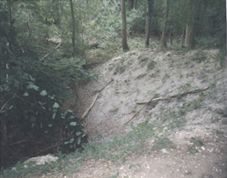 Early on the morning of 18 July 1944, 21 Halifax bombers of 578 Squadron took off from Burn to attack fortified villages near Caen in France. On the outward flight, LK-Q developed a fire which the crew were unable to control. In his anxiety to avoid the heavily populated areas of Reading, Maidenhead and Windsor, the Pilot steered into open country before the fully fuelled and armed aircraft lost altitude and exploded in mid air over the dense wood near Pinkney’s Green. Miraculously, the Canadian rear gunner Flt.Sgt. Hugh Sloan, was blown upwards out of his turret and managed to parachute to safety and return to duty but the rest of his crew perished without trace. Their names are recorded on panels of the Commonwealth Air Forces Memorial to the Missing at Runnymede.
Early on the morning of 18 July 1944, 21 Halifax bombers of 578 Squadron took off from Burn to attack fortified villages near Caen in France. On the outward flight, LK-Q developed a fire which the crew were unable to control. In his anxiety to avoid the heavily populated areas of Reading, Maidenhead and Windsor, the Pilot steered into open country before the fully fuelled and armed aircraft lost altitude and exploded in mid air over the dense wood near Pinkney’s Green. Miraculously, the Canadian rear gunner Flt.Sgt. Hugh Sloan, was blown upwards out of his turret and managed to parachute to safety and return to duty but the rest of his crew perished without trace. Their names are recorded on panels of the Commonwealth Air Forces Memorial to the Missing at Runnymede.
Half a century later Hugh Cawdron, a member of the 578 Burn Association, became aware of this tragedy and made reference to it in his book ‘Based at Burn’ a history of 578 Squadron, published in 1994. Determined to research the matter further and in detail, he iniated a programme of discovery with the intention of creating a memorial, to place on permanent record for subsequent and largely unknowing generations, the true circumstances of the tragedy. The Woodland Trust, owners of the land, generously gave permission for the area to be used for such purpose.
Assisted by a small group of local volunteers, the immediate task was to clear matted undergrowth, including that in the largest of three craters in the Wood which, after fifty years of erosion, still measured 30 yards wide and six yards deep.
After a lengthy period of detailed investigation of Air Force and Imperial War Museum records, interviews with 578 Squadron veterans, wartime local inhabitants and, aided by the local press, contact was made with aircrew relatives overseas. Generous financial contributions were received from the Hopper family of Canada and the Starkoff family from Australia, which, with income raised from the sales of ‘Based at Burn’ was sufficient to commence construction of the Memorial itself, utilising the welcome gift of a pitch pinewood baulk, donated by a local millwright. The assembly was completed by an engraved stainless steel plate bearing the names and other particulars of the crew of LK-Q and its operation.
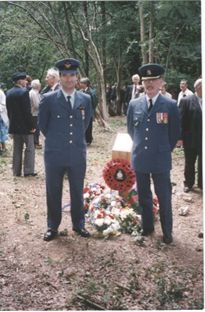
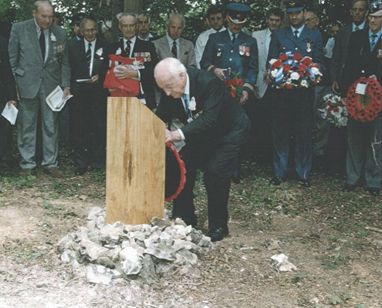
Also present were officers of the Royal Air Force, Royal Canadian and Royal Australian Air Forces, the Mayor of Windsor and Maidenhead and a large gathering of 578 Burn Association members as well as over one hundred local people.
Speakers at the ceremony stressed that the true memorial being dedicated was the Crater.
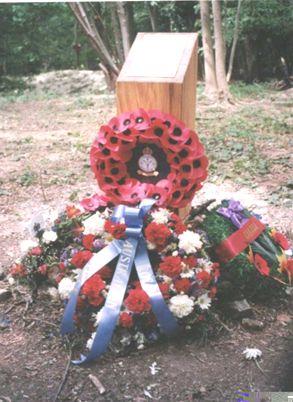

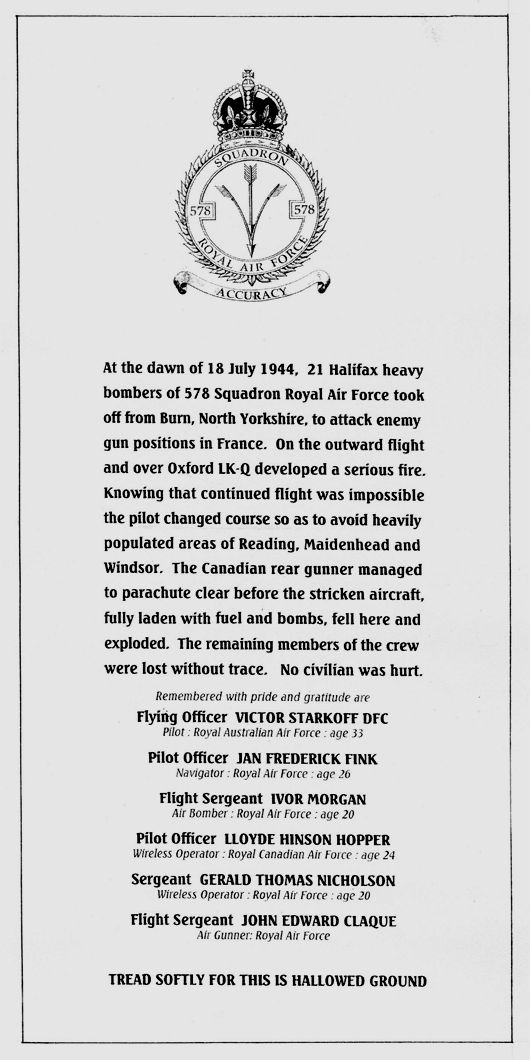
News of the Memorial spread far beyond the local district. The Woodland Trust reported a welcome steady increase of visitors, some of whom had travelled considerable distances. Organised study tours by schoolchildren and others became a regular occurrence.
It was inevitable that, after a decade, the former softwood column should have deteriorated to the stage when replacement was necessary. This time, Hugh Cawdron designed and made the main frame using mild steel tubes and angle, all heavily galvanised after fabrication before receiving an extra protective decoration of powder coating. Visual contrast was achieved by the use of stainless steel for the engraved citation plate, the turned steel finials and arrow. Close attention was given in the design to ensure that rainwater and leaves should not collect on the citation plate.
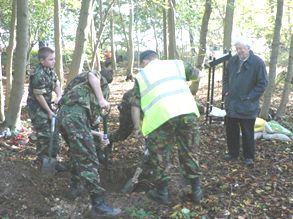
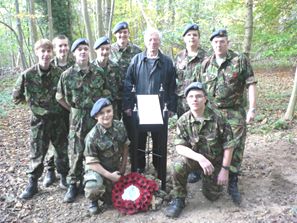
Willing labour was required to convey the heavy memorial, together with tools, cement, sand and water via a half mile long rutted track to site in an icy mid November, remove the firmly bedded pinewood column and bed the replacement. Members of 155 Squadron (Maidenhead) Air Training Corps, who had provided assistance in the past, required no persuasion and the task was well and truly completed in November 2008.
Click here to return to the list of 578 Squadron memorials